SpartanNash Bundle
Can SpartanNash Thrive in Today's Grocery Wars?
In the dynamic world of food retail and distribution, understanding the SpartanNash SWOT Analysis is crucial for any investor or strategist. SpartanNash, a major player in the SpartanNash industry, faces a complex SpartanNash competitive landscape shaped by evolving consumer demands and intense rivalry. This analysis delves into the company's position, examining its strengths, weaknesses, opportunities, and threats to provide a comprehensive view.
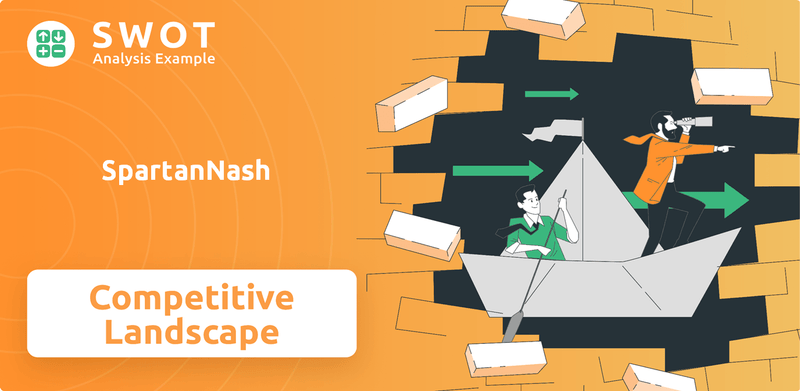
This examination will dissect the SpartanNash competitors, assess its SpartanNash market analysis, and explore the SpartanNash business strategy driving its operations. We'll explore the SpartanNash grocery market dynamics, including SpartanNash market share analysis and SpartanNash key competitors list, to provide a clear picture of its competitive advantages and challenges. Furthermore, we will analyze SpartanNash financial performance compared to competitors and its potential for future growth, providing actionable insights for informed decision-making.
Where Does SpartanNash’ Stand in the Current Market?
The core operations of SpartanNash involve food distribution, retail grocery stores, and services to the U.S. military. The company's value proposition centers on providing comprehensive supply chain solutions, efficient distribution, and strong partnerships within the grocery and military sectors. This approach allows SpartanNash to serve a diverse customer base, from independent grocers to military commissaries worldwide.
SpartanNash's business strategy emphasizes supply chain optimization and digital transformation. This strategy aims to enhance service offerings and improve retail operations, including expanding its direct-to-consumer presence. The company's market position is further strengthened by acquisitions and strategic partnerships that drive growth and diversification.
SpartanNash holds a significant position in the food distribution and retail sectors. Its Food Distribution segment serves about 2,100 independent retail customers across 47 states and internationally. The Retail segment operates approximately 144 corporate-owned grocery stores. The Military segment is a key component, making SpartanNash a leading distributor to U.S. military commissaries and exchanges globally.
SpartanNash's food distribution network is a key aspect of its competitive positioning. The company distributes to about 2,100 independent retail customers. This segment provides a crucial service to independent grocers, helping them compete with larger chains. This focus allows SpartanNash to maintain a strong presence in the grocery market.
The retail segment of SpartanNash operates approximately 144 corporate-owned grocery stores. These stores, under banners like Family Fare and Martin's Super Markets, provide a direct-to-consumer presence. The retail operations are primarily located in the Midwest, enhancing the company's brand recognition and market share.
SpartanNash is a top distributor to U.S. military commissaries and exchanges worldwide. This segment is crucial for the company's revenue and strategic positioning. The military segment's focus on serving military families globally provides a stable revenue stream.
For the fiscal year ended December 30, 2023, SpartanNash reported net sales of $9.6 billion. This financial performance underscores the company's scale and impact within the grocery market and its ability to maintain a strong competitive position. Understanding the financial health of SpartanNash is crucial for evaluating its market position. Learn more about the company's financial aspects by reading about Owners & Shareholders of SpartanNash.
SpartanNash's competitive positioning is defined by its strong presence in food distribution, retail, and the military segment. The company's focus on supply chain optimization and digital transformation enhances its service offerings and operational efficiency. This market analysis reveals that SpartanNash has a well-defined strategy.
- Leading food distributor to independent grocery retailers across 47 states.
- Primary distributor to U.S. military commissaries and exchanges worldwide.
- Operator of approximately 144 corporate-owned grocery stores.
- Focus on supply chain optimization and digital transformation.
SpartanNash SWOT Analysis
- Complete SWOT Breakdown
- Fully Customizable
- Editable in Excel & Word
- Professional Formatting
- Investor-Ready Format
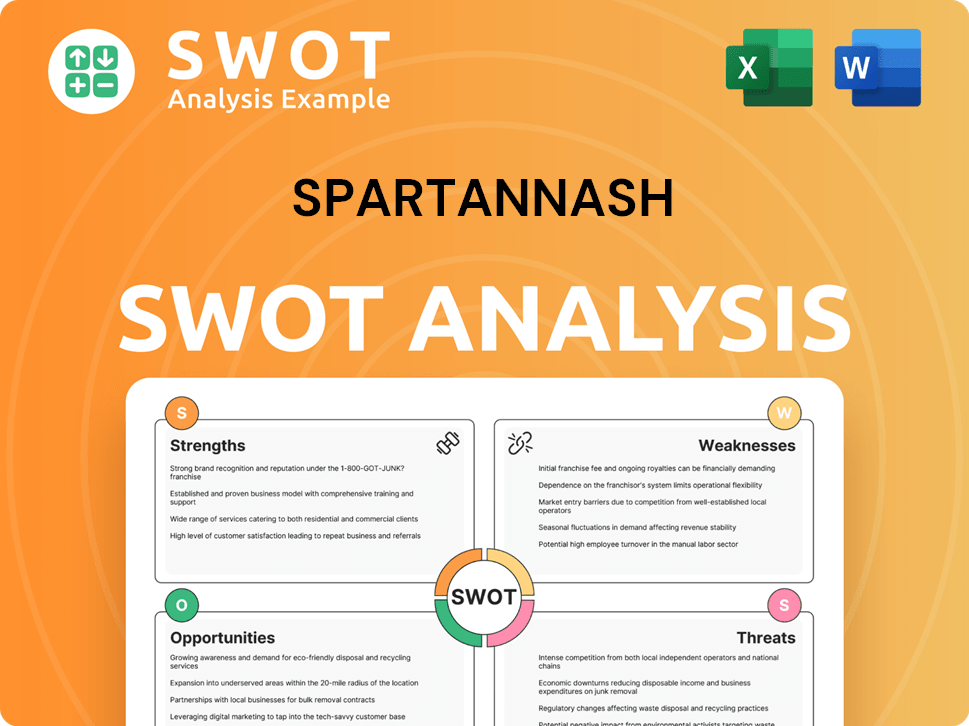
Who Are the Main Competitors Challenging SpartanNash?
Understanding the SpartanNash competitive landscape is crucial for investors and strategists. The company operates in diverse segments, each with unique challenges and a distinct set of SpartanNash competitors. This analysis will help to understand the SpartanNash market analysis and its position within the SpartanNash industry.
The company's performance is heavily influenced by its ability to navigate these competitive pressures. Analyzing these competitors provides insights into the SpartanNash business strategy and potential areas for growth and improvement. The SpartanNash grocery market is dynamic, and this analysis provides a snapshot of the current competitive environment.
In food distribution, the primary competitors are broadline distributors. These competitors challenge SpartanNash through pricing, distribution efficiency, and product offerings. C&S Wholesale Grocers, AWG, and UNFI are key players in this segment.
The retail segment faces competition from national, regional, and local grocery chains, supercenters, and discount stores. Walmart, Kroger, Meijer, and Aldi are significant competitors. These rivals often compete through aggressive pricing and loyalty programs.
In the military segment, SpartanNash competes with other authorized distributors and commercial retailers near military bases. Government contracts and logistical capabilities are critical in this segment. Emerging e-commerce players also pose a threat.
Competition is intense across all segments, with pricing, efficiency, and product assortment being key differentiators. The rise of e-commerce and direct-to-consumer models adds further pressure, requiring continuous investment in digital capabilities.
Analyzing SpartanNash market share analysis reveals the company's position relative to its competitors. This analysis considers the impact of recent acquisitions and strategic partnerships. Understanding the competitive landscape is crucial for future growth.
SpartanNash competitive advantages include its distribution network and relationships with independent grocers. The company must continually adapt to changing retail market trends and invest in its e-commerce strategy to maintain its position. Further insights can be found in the Target Market of SpartanNash article.
The SpartanNash key competitors list includes a diverse range of companies. Understanding these competitors is essential for evaluating SpartanNash financial performance compared to competitors. The company faces significant SpartanNash supply chain challenges and must optimize its SpartanNash distribution network analysis.
- SpartanNash competes with large national chains like Walmart and Kroger, as well as regional players like Meijer.
- In food distribution, competitors include C&S Wholesale Grocers, AWG, and UNFI.
- The military segment faces competition from other authorized distributors and commercial retailers.
- E-commerce and direct-to-consumer models are evolving competitive threats across all segments.
SpartanNash PESTLE Analysis
- Covers All 6 PESTLE Categories
- No Research Needed – Save Hours of Work
- Built by Experts, Trusted by Consultants
- Instant Download, Ready to Use
- 100% Editable, Fully Customizable
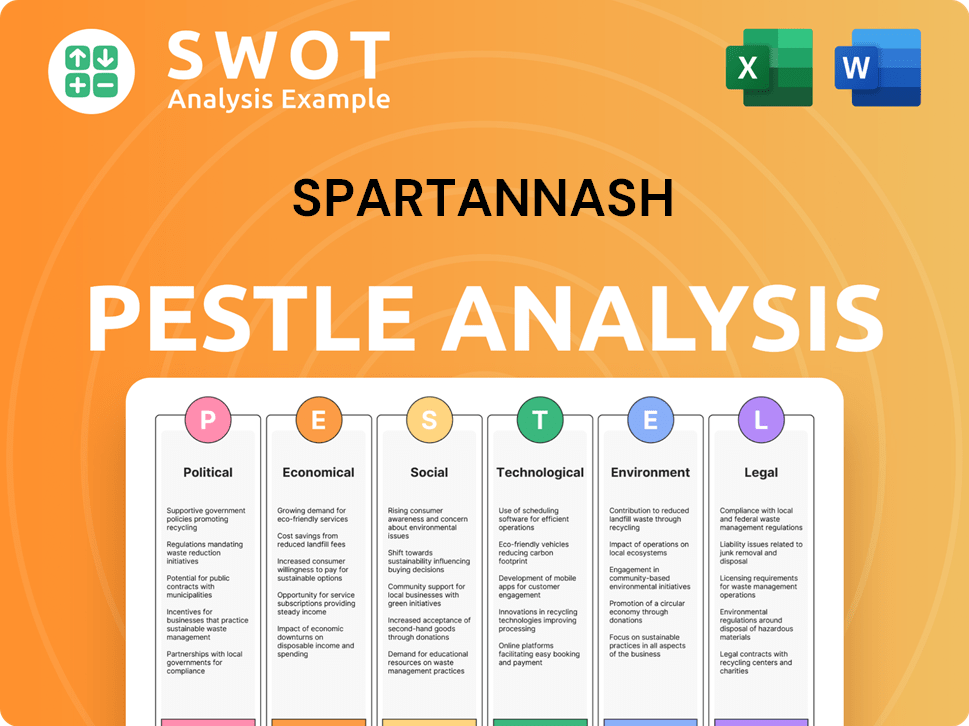
What Gives SpartanNash a Competitive Edge Over Its Rivals?
Understanding the Growth Strategy of SpartanNash requires a deep dive into its competitive advantages. These advantages are crucial for its success in the grocery market and the broader SpartanNash competitive landscape. The company's strategic positioning is a key factor in its ability to compete effectively. The following analysis provides insights into the strengths that set it apart from its competitors.
One of the primary strengths of SpartanNash is its integrated business model, which combines food distribution with retail operations. This dual role allows for better inventory management and demand forecasting, contributing to operational efficiencies. Additionally, the company's extensive distribution network and strong relationships with independent retailers and the U.S. military create a stable revenue base and a competitive edge. This integrated approach is essential for understanding the SpartanNash market analysis.
The company has been investing in technology and supply chain enhancements to improve operational efficiencies and better serve evolving customer needs. This focus on optimizing its supply chain contributes to cost efficiencies and improved service levels. These initiatives are critical for maintaining a competitive position in the dynamic grocery market. The company's strategic partnerships and focus on supply chain efficiency are key elements of its business strategy.
SpartanNash's integrated model combines food distribution and retail operations. This integration provides unique insights into both wholesale and consumer market dynamics. It allows for better inventory management and demand forecasting, enhancing operational efficiency.
The company's distribution network spans 47 states and international locations for military commissaries. This extensive network provides economies of scale and geographic reach. It supports strong relationships with independent grocers and the U.S. military.
SpartanNash has built long-standing relationships with independent grocers based on trust and tailored service. Its position as a leading distributor to the U.S. military is a stable revenue stream. These relationships foster strong customer loyalty and provide a competitive edge.
The company invests in technology and supply chain enhancements, including warehouse management systems and e-commerce platforms. These investments improve operational efficiencies and better serve evolving customer needs. Recent initiatives streamline the network and enhance IT infrastructure.
SpartanNash's key competitive advantages include its integrated business model, extensive distribution network, and strong customer relationships. The company's focus on technology and supply chain enhancements further strengthens its position. These advantages are critical for navigating the SpartanNash industry and maintaining a strong market presence.
- Integrated Business Model: Combines food distribution and retail operations.
- Extensive Distribution Network: Spans 47 states and international locations.
- Strong Customer Relationships: With independent grocers and the U.S. military.
- Technology and Supply Chain Investments: Enhancements for operational efficiency.
SpartanNash Business Model Canvas
- Complete 9-Block Business Model Canvas
- Effortlessly Communicate Your Business Strategy
- Investor-Ready BMC Format
- 100% Editable and Customizable
- Clear and Structured Layout
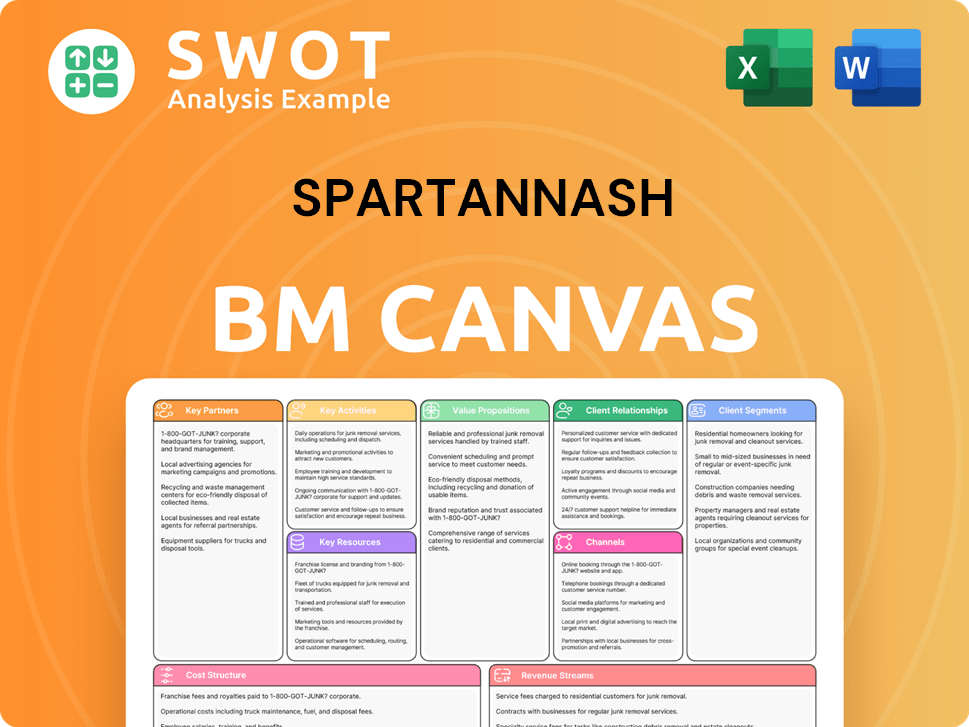
What Industry Trends Are Reshaping SpartanNash’s Competitive Landscape?
The SpartanNash competitive landscape is significantly influenced by industry trends, future challenges, and emerging opportunities. The company navigates a dynamic environment shaped by technological advancements, evolving consumer preferences, and economic shifts. Understanding these factors is crucial for assessing SpartanNash's business strategy and its ability to maintain a competitive edge in the grocery market.
The food distribution and retail sectors are experiencing substantial transformation. SpartanNash's industry position requires continuous adaptation to remain competitive. This involves strategic responses to both immediate challenges and long-term opportunities, ensuring the company's resilience and growth potential in a complex market.
Technological advancements in e-commerce and supply chain automation are reshaping the grocery sector. Consumer demand for online grocery shopping is increasing, necessitating investment in digital platforms. Regulatory changes concerning food safety and sustainability also impact operational costs and compliance.
Increased competition from larger national chains and new market entrants poses a significant threat. Economic shifts, including inflation and supply chain disruptions, impact commodity prices and operational stability. Adapting to these challenges requires strategic agility and robust financial planning.
Optimizing the supply chain through automation and data analytics presents growth opportunities. Expanding private label offerings and forming strategic partnerships can enhance margins and customer loyalty. Leveraging the strong military distribution segment offers potential for expansion.
SpartanNash is focusing on supply chain efficiency, digital transformation, and targeted retail growth. The company aims to become a more digitally integrated and agile operation. This approach is designed to effectively serve both wholesale and retail customers.
To understand the competitive dynamics, it's important to examine SpartanNash's competitors and their strategies. SpartanNash's market analysis reveals key players and their respective strengths and weaknesses. The SpartanNash competitive advantages include its established distribution network and strong relationships within the military segment. For a deeper dive into the company’s performance, consider reading this article about SpartanNash .
- The company faces challenges from larger national chains expanding their distribution networks.
- Economic pressures, including inflation, continue to impact operational costs.
- Opportunities exist in supply chain optimization and expansion of private label offerings.
- The company is focusing on digital transformation and strategic partnerships to boost growth.
SpartanNash Porter's Five Forces Analysis
- Covers All 5 Competitive Forces in Detail
- Structured for Consultants, Students, and Founders
- 100% Editable in Microsoft Word & Excel
- Instant Digital Download – Use Immediately
- Compatible with Mac & PC – Fully Unlocked
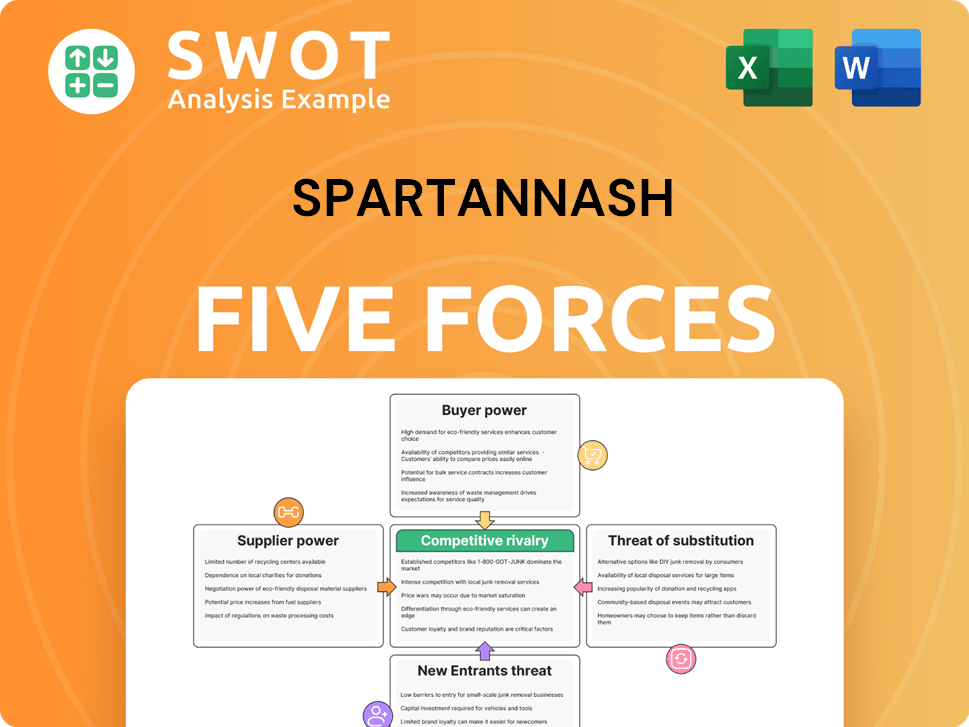
Related Blogs
- What are Mission Vision & Core Values of SpartanNash Company?
- What is Growth Strategy and Future Prospects of SpartanNash Company?
- How Does SpartanNash Company Work?
- What is Sales and Marketing Strategy of SpartanNash Company?
- What is Brief History of SpartanNash Company?
- Who Owns SpartanNash Company?
- What is Customer Demographics and Target Market of SpartanNash Company?
Disclaimer
All information, articles, and product details provided on this website are for general informational and educational purposes only. We do not claim any ownership over, nor do we intend to infringe upon, any trademarks, copyrights, logos, brand names, or other intellectual property mentioned or depicted on this site. Such intellectual property remains the property of its respective owners, and any references here are made solely for identification or informational purposes, without implying any affiliation, endorsement, or partnership.
We make no representations or warranties, express or implied, regarding the accuracy, completeness, or suitability of any content or products presented. Nothing on this website should be construed as legal, tax, investment, financial, medical, or other professional advice. In addition, no part of this site—including articles or product references—constitutes a solicitation, recommendation, endorsement, advertisement, or offer to buy or sell any securities, franchises, or other financial instruments, particularly in jurisdictions where such activity would be unlawful.
All content is of a general nature and may not address the specific circumstances of any individual or entity. It is not a substitute for professional advice or services. Any actions you take based on the information provided here are strictly at your own risk. You accept full responsibility for any decisions or outcomes arising from your use of this website and agree to release us from any liability in connection with your use of, or reliance upon, the content or products found herein.